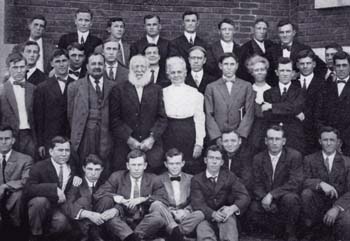
that the kindly “Dorm Mother,” center, of Fiske Hall was also
a lawyer, Congregational minister, editor, friend of Susan B.
Anthony, author of The Philosophy of Love, English professor
— and adviser to both the suffragists of Fairmount College
and its anti-suffragists. Ella (White) Brown, a nationally known
lecturer on suffrage and temperance, taught at Fairmount
from 1908 to 1913 and proved herself “one of the more
important women in our campus history.”
A woman of firsts, Fairmount College’s Ella (White) Brown spoke out nationally for the Woman Suffrage Amendment.
In this 85th year since American women won the right to vote, Wichita’s chapter of the League of Women Voters is actively collecting stories and ideas for local celebrations of the 19th amendment to the U.S. Constitution.
Plenty of stories connect Wichita State to the suffrage movement, but one of the best examples is that of Ella (White) Brown, who taught at Fairmount College from 1908 to 1913.
“She is one of the more important women in our campus history,” says George Platt, WSU associate professor emeritus, of the nationally known lecturer on suffrage and temperance who was also a practicing Kansas lawyer, teacher, Congregational minister and matron of Fiske Hall dormitory, the oldest building on the WSU campus.
Ella White was born in Piqua, Ohio, in 1861, 13 years after the legendary women’s rights convention in Seneca Falls, N.Y. Her childhood ran parallel to some of the most turbulent times in the nation with debates over slavery, women’s rights and alcohol.
In 1878, the same year that a Woman Suffrage Amendment was first introduced in Congress, she married John Campbell Brown, a faculty member at Central Normal College in Danville, Ind., where she would graduate in 1882.
The Browns headed to Holton, Kan., in 1883 for faculty jobs at Campbell University. John also practiced law in the town and supported Ella when she went to the University of Kansas School of Law in 1890 and knocked out the two-year coursework in one.
In 1891, she was the first woman to graduate from KU’s law school. She and her husband went into practice as the firm of Brown and Brown, and she was named Holton’s city attorney in 1893 — another first for a woman in Kansas.
She also became pastor of the Congregational Church in Powhattan, Kan. After her husband’s death in 1904, she moved to Powhattan and served the church until 1907 while still teaching commercial and parliamentary law at Campbell University.
“By this time,” says Platt, who has extensively researched WSU’s early history, “she was a popular speaker in both the suffrage and temperance movements.” Platt adds that Brown was a friend of Susan B. Anthony and served as parliamentary law chairwoman for the National Suffrage Association.
She was also parliamentarian of the Kansas Equal Suffrage Association. Her time in Kansas overlapped that organization’s big statewide push in 1911 and 1912 for legislative approval of the Woman Suffrage Amendment. “Suffrage is more than lukewarm here,” reported Brown in 1912, speaking of Sedgwick County.
Still, the amendment passed both houses of the Kansas Legislature in 1912 and went to the voters on Nov. 5 of that year. The final count showed 175,246 votes for the amendment and 159,197 against.
Brown left Kansas the following year to teach at Pomona College in California. She would later be named dean of women at what is now East Stroudsburg University of Pennsylvania. She retired from there in the 1930s, moved to Florida and taught Bible studies for the Winter Park Congregational Church. She died in 1947 and was buried in Piqua, next to her husband.
The Pros & the Cons
State legislative approval of the Woman Suffrage Amendment was still months in the future when members of Fairmount College’s 1912 Parnassus staff reported on the activities of two campus clubs, one for, the other more or less against, women’s right to vote:
Motto: Votes for Women
The women suffragists of Fairmount have organized. They seem to have wearied of being the power behind the throne, and are trying to be the power on it. Miss Mary Dobbs presided over the meeting. Students elected: Marjorie McMahon, John Elliott, Madge Bishop and Bess Jones. The members have chosen as the Advisory Board, Dr. Thayer, and Professors Neff, Hoare and Brown. Next fall the amendment which will make women legal voters comes up, and it is the suffragists’ intention to win the fight and give women the privilege of using their long denied rights. The local organization has some fifty members, and is still growing.
Motto: Oppose the Others
While the ballots were being counted for the suffrage leaders, the anti-suffragists were organized amid great enthusiasm. They elected: Ruth Edwards, President; Vera Knoblauch, Vice President; Herbert Seamans, Treasurer; Lester Lee, Secretary; David Carlson, Sergeant-at-Arms; and chose as Advisory Committee: Mrs. Ella W. Brown, Dr. H. E. Thayer, Prof. Frank Neff, and Dean Arthur J. Hoare. This very active bunch has already held one banquet, after which they went to hear Jane Addams at the Crawford. They went home with their minds in chaos and some have crystallized in favor of suffrage.





